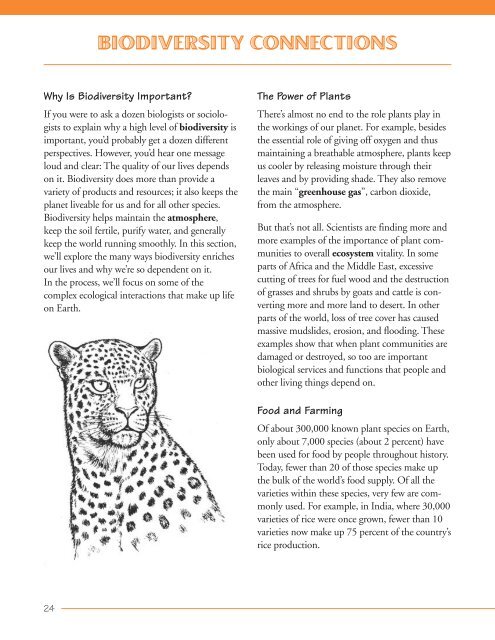EXPLORING BIODIVERSITY: A Guide for Educators Around the World
EXPLORING BIODIVERSITY: A Guide for Educators Around the World
EXPLORING BIODIVERSITY: A Guide for Educators Around the World
Create successful ePaper yourself
Turn your PDF publications into a flip-book with our unique Google optimized e-Paper software.
<strong>BIODIVERSITY</strong> CONNECTIONS<br />
Why Is Biodiversity Important?<br />
If you were to ask a dozen biologists or sociologists<br />
to explain why a high level of biodiversity is<br />
important, you’d probably get a dozen different<br />
perspectives. However, you’d hear one message<br />
loud and clear: The quality of our lives depends<br />
on it. Biodiversity does more than provide a<br />
variety of products and resources; it also keeps <strong>the</strong><br />
planet liveable <strong>for</strong> us and <strong>for</strong> all o<strong>the</strong>r species.<br />
Biodiversity helps maintain <strong>the</strong> atmosphere,<br />
keep <strong>the</strong> soil fertile, purify water, and generally<br />
keep <strong>the</strong> world running smoothly. In this section,<br />
we’ll explore <strong>the</strong> many ways biodiversity enriches<br />
our lives and why we’re so dependent on it.<br />
In <strong>the</strong> process, we’ll focus on some of <strong>the</strong><br />
complex ecological interactions that make up life<br />
on Earth.<br />
The Power of Plants<br />
There’s almost no end to <strong>the</strong> role plants play in<br />
<strong>the</strong> workings of our planet. For example, besides<br />
<strong>the</strong> essential role of giving off oxygen and thus<br />
maintaining a breathable atmosphere, plants keep<br />
us cooler by releasing moisture through <strong>the</strong>ir<br />
leaves and by providing shade. They also remove<br />
<strong>the</strong> main “greenhouse gas”, carbon dioxide,<br />
from <strong>the</strong> atmosphere.<br />
But that’s not all. Scientists are finding more and<br />
more examples of <strong>the</strong> importance of plant communities<br />
to overall ecosystem vitality. In some<br />
parts of Africa and <strong>the</strong> Middle East, excessive<br />
cutting of trees <strong>for</strong> fuel wood and <strong>the</strong> destruction<br />
of grasses and shrubs by goats and cattle is converting<br />
more and more land to desert. In o<strong>the</strong>r<br />
parts of <strong>the</strong> world, loss of tree cover has caused<br />
massive mudslides, erosion, and flooding. These<br />
examples show that when plant communities are<br />
damaged or destroyed, so too are important<br />
biological services and functions that people and<br />
o<strong>the</strong>r living things depend on.<br />
Food and Farming<br />
Of about 300,000 known plant species on Earth,<br />
only about 7,000 species (about 2 percent) have<br />
been used <strong>for</strong> food by people throughout history.<br />
Today, fewer than 20 of those species make up<br />
<strong>the</strong> bulk of <strong>the</strong> world’s food supply. Of all <strong>the</strong><br />
varieties within <strong>the</strong>se species, very few are commonly<br />
used. For example, in India, where 30,000<br />
varieties of rice were once grown, fewer than 10<br />
varieties now make up 75 percent of <strong>the</strong> country’s<br />
rice production.<br />
24

















